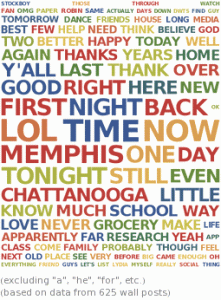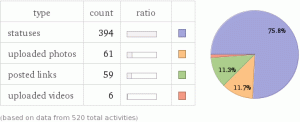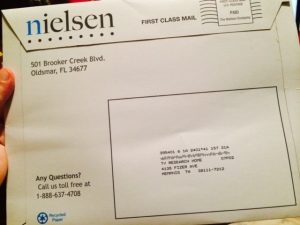Thanks to all of you guys who have followed and seemingly enjoyed #Bones’ journeys for my #photoaday challenge for grad school. He says he’s had enough notoriety for now, though, so it’s back to ‘business.’ Farewell!

I”ve been an Instagram user since 2012. As such, I guess this is not an appropriate medium to use for an assignment that instructed us to use a new tool and one not discussed in class. I’m pretty sure we didn’t take up Instagram officially in class, so maybe it qualifies at least on that front. But how I feel it IS appropriate to select ths platform for this assignment is because I have suddenly gained insight on how to use the application right. So it’s like it’s all new to me.
What caused me to realize some things about my Instragram use was a link shared by Nitzana that offered analytics for Instagram use. It’s called Iconosquare. And it’s very easy to use. But reading those results were not easy. Let me explain.
Because for once in my life I was a fairly early adopter with Instagram (within my circle of friends in Chattanooga, at least), I’ve had an opinion that my IG account was pretty darn active. I like to take photos, and I also like to archive them. IG has been a great outlet and resource on this front, beyond being terribly fun to see the ways all my fellow users employed the app. It has felt like that my IG has been pretty popular–highly frequented even.
![]()
Not so much. The metrics don’t lie. I was somehow deluded about what kind of activity I had been putting into my IG.
For example: My most liked potos have some miserable rankings in the scheme of things.15? Seriously? That’s might highest number of likes? I was convinced I had higher numbers than that.
And what about my frequent buddies showing me IG love? I know that certainly there are a few on my friends list that like EVERYTHING I post. Deluded again. So many posts, and even Renay–my best friend of over 20 years–has only liked me 27 times. Really? This has all made me do something thinking. And it occurred to me. “Maybe it’s because you don’t have enough IG friends.”![]()
Simple enough realization, I guess, but it hadn’t happened because I was too busy focusing on quality and content posted instead of the size of my audience. Well I fixed that. I revamped my friends list to include as many people in my contacts list I could thing to add. I’ve seen an increase on my friends list of over 45 people in the last week.
So yeah. IG is new. For me. I’ve been SHOCKED at how much new activity has been prompted. And i’m excited to see how this platform can help me grow my engagement within the social media realm.
This Social Media Theory journey has been enjoyable, but much more difficult than I even imagined. I knew what my challenges would be at the beginning. Hurdles like lack of experience, being a digital immigrant and the whole ‘behind the curve’ identity I have yoked myself with perennially plague me. And most of those realities played a part.
But nothing was as difficult for me during this course as was overcoming my innate tendency to be a late adopter. Repeatedly when assignments came around, a general, life-long habit to wait/psych myself up to trying new ways of social media interaction caused dread and anxiety and often caused me to wait too long. Indeed, I got very far behind in this course–more so than I might’ve ever in any other college course. I’m not proud of that.
Miraculously and as it turns out, my tendency to be a late adopter is not from incapability (or from fear of it, at least). I can happily report at the end that, more often than I expected, navigating and wrangling new forms of social media endeavor was far easier than I guessed and was always enjoyable. It was good to learn as a sidebar to the course that I’m not a total idiot, whether I might’ve felt that way a few times in the last few months or not. Indeed, I’ve made myself proud, where the ‘how to’ aspect of the course comes into play.
But on the notion of the use and practice aspect of social media, I can honestly say that a comprehensive retrospective provides me with a somewhat decent handle on the scope of how social media works for creating an online presence. Managing and maintaining the sites is constant work. But it’s more than just creating content and making sure everything is current. It’s about doing so with a cohesive mentality and with an appropriate message for a targeted audience in mind. It’s about branding. And it’s about making the most of the respective social media’s functionality as it most appropriately benefits the brand.
I’ll admit, my own brand has been all over the map this semester. What I intended to create with the GayGaze blog was/is just too uncomfortable for me. So, in light of that, I changed courses midstream to promote my creative writing on the journal blog. And I’ll have to confess that I didn’t live up to my self-challenges on that front either.
In effect, all of these observations lead to a perspective that I did not expect to gain by the end of this course: social media management is a tough job. It’s a busy job. And now more significantly than ever, I see that it is an important job. And I feel incredibly more equipped to tackle it if a professional opportunity ever comes my way.
Assignment: In your journal blog, describe what your Facebook strategy and goals might be.
I’ve repeatedly established that I’m a good bit behind the curve when it comes to social media adoption and use. I typically have only co-opted to use social media because everyone else was. That was the case initially, for sure. It was incumbent to create a MySpace and then, even though I had a healthy presence there, I felt pretty much forced to go over to FaceBook because everyone else did.
Naturally, I was slow to be active on FaceBook. At once I learned it was a different animal than MySpace–not nearly as blog friendly and it lacked alot of the visual appeal and personalization aspects I had grown to enjoy on MySpace. But because I had learned the value of using MySpace as a “stage” where I “performed” for my willing fans (through blogging or posting videos of myself performing on stage at that time or through the ease of archiving pictures on that site), I did my best to adapt to FaceBook’s “stage.” This was an altogether different performance, though–much more succinct and far less personal.
Over the years, I’ve learned that being succinct and less personal is a good thing for me though. We know that general privacy rapidly becomes a larger concern, as discussed in this week’s reading. It’s on the note of personal privacy where FaceBook and social media in general are growing concerns for me.
I’ve said it before–my sexuality is not something I typically broadcast when I can’t control the audience. And that’s largely out of respect for the audience. Not everyone I know either wants to or needs to know that I’m same-sex attracted. (Indeed, when I was MySpace active, an anonymous person printed out a photo of myself with my boyfriend at the time from that site, taped it to a post card and mailed the photo to my mother. Luckily she never saw that because my sister-in-law scooped it out of my parents’ mailbox just in time. You can’t make this stuff up.)
And recently and to divulge another sensitive story in my personal life, I was messaged on FaceBook by a friend of my daughter’s family (yes, I said daughter) disparaging me about how I hadn’t been involved in that little girl’s life (long story). I made some major changes to my privacy settings after that incident by limiting my visibility to friends only. And by blocking not a few people. Social media makes the world smaller. And indeed, my social media presence and participation is precarious.
Because of the various and sundry issues, my FaceBook strategy has always been a sort of “what they don’t know won’t hurt ’em” mentality–and further, “be very careful about what you DO let ’em know.” I’ve let my hair down since I moved to Memphis, and because I value the “stage” aspect of social media more than ever before because most of my friends live over six hours away and because they’ve grown accustomed to my “performances.”
But the performance has had to be altered.
I used a FaceBook analytics program called Wolframalpha to actually get a handle on what is really going on with my FaceBook activity so I can be more sensible about how to best use it for my personal brand going forward.
The results were, to be conversational about it, very cool.
For example, it’s good  to know my friends are largely female. They’re usually more comfortable with gay guys. And the ladies on my friends list have evidenced they’re by far bigger fans of #Bones. This knowledge will help me in going forward to know that I’m working with an audience that is almost 2/3 female.
to know my friends are largely female. They’re usually more comfortable with gay guys. And the ladies on my friends list have evidenced they’re by far bigger fans of #Bones. This knowledge will help me in going forward to know that I’m working with an audience that is almost 2/3 female.
I learned about my typical FaceBook activity from this metric analysis. We read more frequently all the time about what time of day is best to post on social m edia.
edia.
I clearly have trends in my personal use. And I believe my habits largely reflect what sources like The Huffington Post indicate are best practices according to time of day to post. This graphic also demonstrates that I largely use my iPhone to post–good information to know regarding purchasing/upgrading mobile phone service.
In considering how I will employ what I’m learning about social media best practices where FaceBook is concerned, I believe it’s also significant for me to consider the content that I post. I’ve seen recently that by linking to my blog on FaceBook creates exponential s pikes on my blog activity. Clearly, I can utilize this technique to drive more traffic to my blog,
pikes on my blog activity. Clearly, I can utilize this technique to drive more traffic to my blog,
considering that I have 768 sets of eyes potentially looking at my FaceBook activity. This makes it all the more important to think more seriously about the wording and writing that I use on FaceBook. My “audience” knows me as a writer. Many of my friends are FaceBook immigrants from back in the day when I blogged heavily on MySpace. They pay attention to my words. And after looking at this word cloud from the analytics, I should pay more attention, too. Evidently I spend alot of time talking about “time” on FaceBook (not altoget her in a positive sense most of the time now that I think about it). “Memphis” and” Chattanooga” are prominent words, as well as “new.” It’s easy to discern from just a glance at this that my FaceBook musings have been largely focused on my recent move to Memphis for grad school. This is a compelling glance at word usage/content.
her in a positive sense most of the time now that I think about it). “Memphis” and” Chattanooga” are prominent words, as well as “new.” It’s easy to discern from just a glance at this that my FaceBook musings have been largely focused on my recent move to Memphis for grad school. This is a compelling glance at word usage/content.
Further and regarding content, it’s clear I need to focus more on posting photos. Studies continue to show that posting pictures is a very effective way to prompt engagement–especially the type of photos that are compelling enough not to warrant captions. As a sometime professional photographer, I understand this and I believe myself cap able in creating content of this nature that can be compelling. These results prompt
able in creating content of this nature that can be compelling. These results prompt
me to be more enthusiastic about posting more photos in the future. Because curation is an important new trend (and because, considering the graphic to the right I hardly every do it), linking to my creative writing blog and other sites of interest is a needful area in my FaceBook usage. It’s a tendencyI’ve largely avoided in the past, but it is inevitable that I must improve in that arena so I can increase engagement with my FaceBook activity.
It’s amazing how infographics and data analytics can create an entirely different perception of one’s activity online. As with many other instances I’m encountering in this course and in graduate school at large, I’m new to alot of this. It actually kinda strikes fear inside me when every week rolls around and some other new social media concept has been mine to tackle. I feel like I’ve been largely successful and functionality in the online realm has increased significantly for my personal brand, for my online recreation and for promotion of my blog.
But when it comes to FaceBook, I’ve been very comfortable in that realm for a long time and have considered myself fairly savvy. But maybe not so much. With increased privacy concerns and with a glance at the figures I’ve included herein, I see several easy activities I can increase on my FaceBook wall that will further my engagement with others. And armed with these new illustrations of that Facebook reality, I can do so with less concern and more wisdom about how to compose content that won’t create further drama where my personal life is concerned.
The goal is increased engagement–especially when I can feel lonely in a new city and when I want to drive people to my blog. But the wisdom is not in simply more content, but the right kind of content–so that increased engagement is achieved but in the most positive way for everyone involved.
.
In our recent readings and exercise dealing with the rapid emergence of data and statistics as a driving new force for journalism, it emerged for me how the use of available data and the visualization of this information could be a significant component for the development of the GayGaze blog.
Considering that the very nature of GayGaze is pertaining to television and how gay men are typically incorrectly or inappropriately respresented therein, it’s significant to consider how inportant visualization and statistics are specifically when it comes to visual media and television in particualr. Words and opinions are important when it comes to a sensitive subject such as stereotypes for any branch of society that might be affected by stereotypical portrayal in the media. This is one important need that the blog provides–a place for me to write about what I see (and especially feel personally) about what strikes me as errant where gay men on television are concerned and for others to respond and participate in the discourse.
But inevitably, it’s not all about words and feelings.
Numbers and visuals must be used to portray the actual premise for the blog. And that is where the quickly emerging field of data-driven journalism comes into play.
The television industry has long been one driven by numbers. With such companies as Nielsen providing a long history of ratings and demographic information to the television industry for television consumption and viewing habits, it’s clear that for this particular arm of the media, numbers are pivotal. (It’s no small coincidence on that note that I was just again selected as a Nielsen “tv research home.” Their work and their numbers are real–I’m living proof!)
But how can these numbers and data play a role on GayGaze? It’s simple. One of the most effective ways to demonstrate the evolution of the portrayal of gay men on television is through compiling this statistical data provided by Nielsen and, more specifically, by GLAAD.
This is where data use and visualization concerning an electronic medium should be fairly easy and very beneficial. GLAAD is an advocacy organization that has specifically monitored the portrayal and inclusion of gays, lesbians, bisexuals and transgenders in the media. According to its website, the organization “amplifies the voice of the LGBT community by empowering real people to share their stories, holding the media accountable for the words and images they present, and helping grassroots organizations communicate effectively. By ensuring that the stories of LGBT people are heard through the media, GLAAD promotes understanding, increases acceptance, and advances equality.”
Fortunately for those who are concerned with portrayal of the gay community on television (such as on my beat blog) and as a function of GLAAD’s above quoted mission, the organization annually releases reports of findings about gay representation in this setting. Its publications such as the “Network Responsibility Index,” “Where We Are on TV” specifically monitors and compiles data to represent representation. These publications are exhaustive and replete with percentages of portrayal by network and break down all the statistics pertaining to gay coverage in television entertainment programming and are available for free download from the organization’s website. This will be a major source of and component of data for the GayGaze blog. While potential blog users could likewise access this information themselves, the GayGaze blog will pare down the information and making it simpler and more visual to the specific topic of gay MEN on television.
Also and as a result of our recent mapping assignment in class, I envision how mapping could also play a role on the blog. While the central topic of the blog is focused on the furtherance of the presentation of heteronormative gay men on television, I’ve included a cultural section on it as well where I provide information for other men like myself to know about cultural aspects that are more to their tastes and comfort levels than perhaps typical gay bars. By doing hands on research, much like I have already documented on the blog, a developing map of whatever city I may live in or drawn from the experiences of others in other cities can provide men who might be same-sex-oriented but who want to know that hard-to-find information about whether to either meet other men like themselves in a social setting or even religious institutions or service providers who may cater to them more appropriately.
Essentially, then, it’s clear how data management from television studies and possibly even mapping services can provide prerogatives for my beat blog in ways that I might never have considered at the blog’s inception.